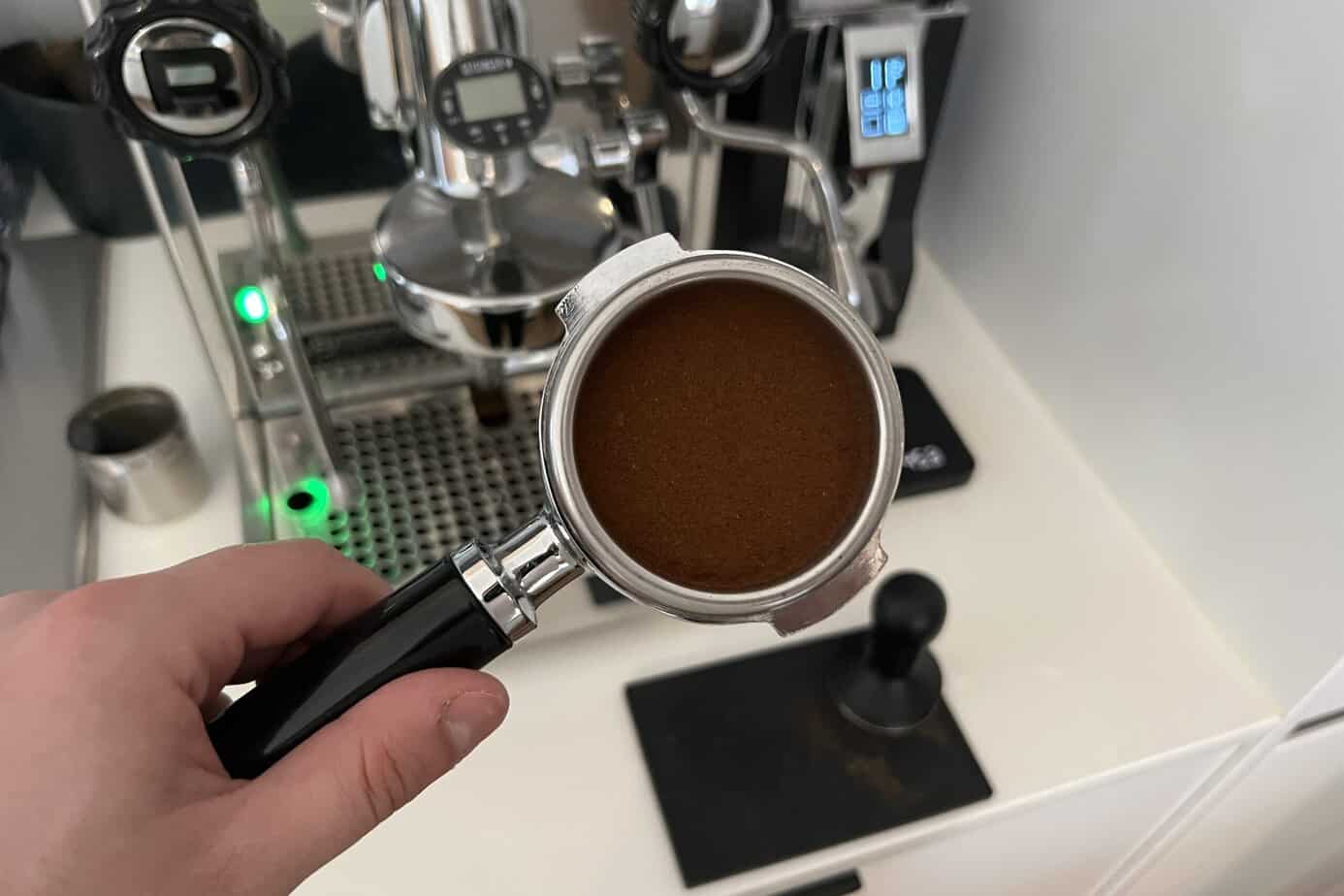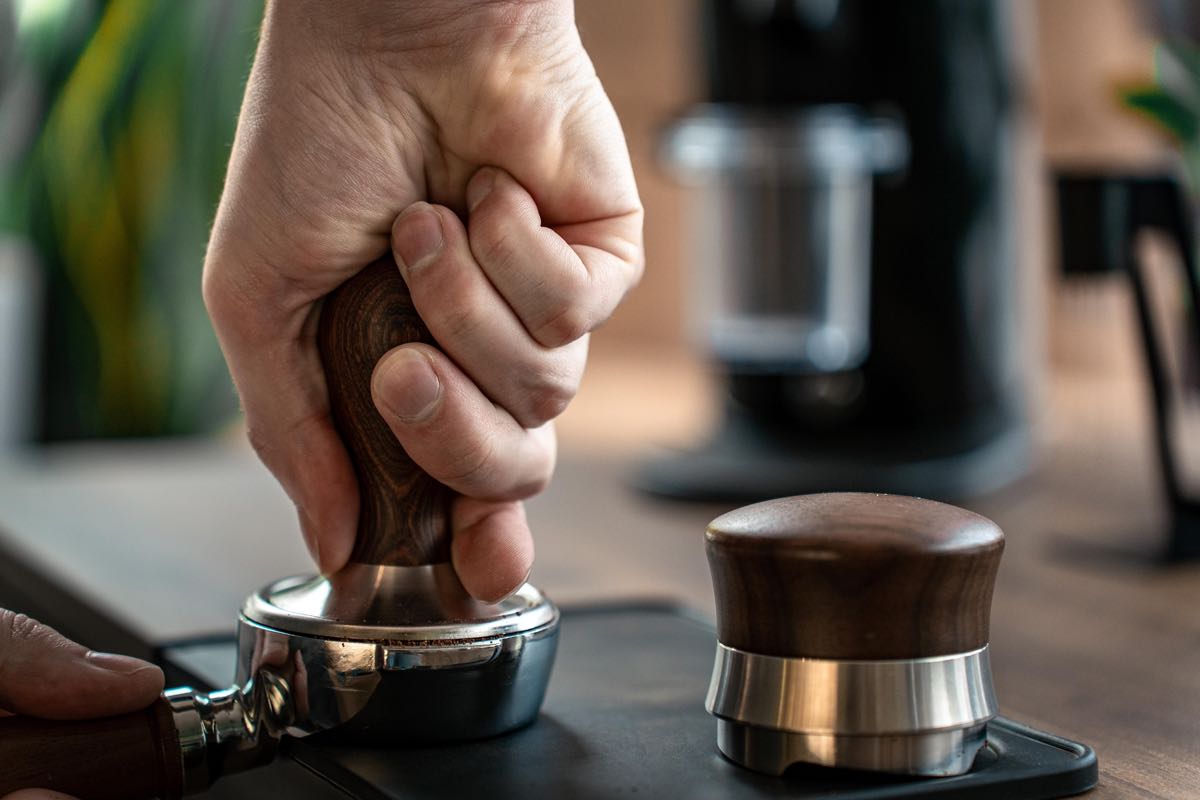Making espresso at home involves more than just using high-quality beans or a well-calibrated espresso machine. One often-overlooked yet critical step is tamping. The pressure and technique you use to tamp the coffee grounds can dramatically influence the flavor and consistency of your espresso shot. So, how hard should you tamp? In this article, I’ll break down the fundamentals of tamping, why it matters, and how you can perfect your technique to achieve the best espresso possible at home. Explore the features and performance of this machine in our Philips 5500 LatteGo review

Why Tamping Matters for Espresso
Tamping is the process of pressing the coffee grounds into a compact, uniform puck in the portafilter before brewing. This step is essential for ensuring that the water flows evenly through the coffee grounds during extraction. If the grounds aren’t tamped evenly, the water will find the path of least resistance, resulting in uneven extraction—this is known as channeling. Dive into the details of the Philips 5400 LatteGo review
Channeling occurs when the water bypasses certain areas of the puck, causing over-extraction in some parts and under-extraction in others. The result? A shot that’s either bitter or sour—definitely not the goal when making espresso. Compare these two models in our Philips LatteGo 5400 vs 4300 review
So, why is tamping so important? When done properly, tamping ensures even distribution of the water, which results in a balanced and well-extracted espresso shot. Without the proper tamp, you risk poor extraction and, ultimately, a disappointing cup of coffee. Discover the differences between these machines in our Philips 3200 vs 4300 vs 5400 review
How Much Pressure Should You Apply When Tamping?
There’s a common rule of thumb in the espresso world: tamp with about 30 pounds (13.6 kg) of pressure. However, this figure is often misunderstood or misapplied. While it's helpful to have a benchmark, tamping pressure isn’t an exact science. What’s more important is consistency. Learn how these two models compare in our Philips 3200 vs 4300 review
In theory, 30 pounds of pressure is just a general guideline, and applying this exact amount is less critical than maintaining a consistent technique every time you tamp. In fact, the real goal is to tamp until the coffee feels compact and stable. This means pressing the tamper down until you feel firm resistance from the grounds, indicating that they are well-compacted. Uncover the key distinctions in our Philips 3200 vs 5400 review
The Right Technique: Tamping for Consistency
Rather than focusing solely on achieving a specific weight or pressure, the goal should be to tamp consistently with each shot. If you tamp with consistent pressure every time, you’ll ensure an even extraction that brings out the best flavors in the coffee.
Let’s break down the steps to achieving the ideal tamp:
1. Distribute the Grounds Evenly
Before you even think about tamping, it’s crucial to ensure that the coffee grounds are evenly distributed in the portafilter. Uneven distribution can lead to uneven tamping, which will result in inconsistent extraction. You can either tap the portafilter gently on the counter or use a distribution tool to make sure the grounds are level and evenly spread.
If you’ve ever encountered uneven shots or noticed that some areas of the puck are more compact than others, the problem may stem from improper distribution before tamping. Taking the time to distribute your grounds properly can prevent many common espresso problems.
2. Position Your Tamper Correctly
Once the grounds are evenly distributed, it’s time to tamp. Hold the tamper with your fingers and make sure your wrist is straight. Your elbow should form about a 90-degree angle to ensure that you’re not straining or overextending yourself while tamping. This position helps you apply uniform pressure, making the tamp more consistent and less likely to result in uneven shots.
The key here is to hold the tamper steady, using your thumb and index finger to control it. A firm, but relaxed grip will allow you to apply even pressure without force.
3. Tamp to Resistance
When tamping, you want to press down slowly and steadily until you feel resistance from the coffee grounds. Once you reach resistance, you know the puck is compacted and stable. There’s no need to apply excessive force beyond this point. Over-tamping, or pressing too hard, can result in over-extraction, leading to bitter flavors.
Some espresso aficionados recommend giving the tamper a slight twist at the end of the tamping process to create a smooth, polished surface. This isn’t a necessity for everyone, but it’s an added step that some find helps with consistency.
4. Focus on Consistency, Not Force
Rather than obsessing over the exact amount of pressure, focus on tamping with a consistent amount of force each time. Consistency ensures that your shots will taste the same each time you brew. Whether you’re pressing with 20 pounds or 30 pounds of pressure, consistency is far more important than hitting an exact figure.
Many espresso machines come with built-in pressure sensors, which can help you measure the amount of pressure you're applying and refine your technique over time. However, for home baristas, the most effective strategy is to practice and learn how to recognize when you’ve tamped enough.
5. Use a Stable Tamping Surface
When tamping, always use a stable surface. A tamping mat or a solid countertop provides the necessary stability to avoid any wobbling or unevenness. A sturdy surface will also allow you to apply even pressure across the tamper, which is crucial for a uniform shot.
Common Tamping Errors to Avoid
Even experienced baristas make tamping mistakes from time to time. Here are a few common errors to avoid when tamping:
1. Tamping at an Angle
Tamping at an angle is one of the easiest ways to ruin your shot. If you press down unevenly, you risk creating an uneven puck. This leads to channeling and inconsistent extraction. Always aim to tamp straight down, with the tamper perpendicular to the portafilter.
2. Inconsistent Pressure
Inconsistent pressure can lead to shots that taste different each time. One shot might be over-extracted and bitter, while another may be under-extracted and sour. The solution is simple: practice tamping with the same amount of pressure every time.
3. Skipping Ground Distribution
Neglecting to evenly distribute the coffee grounds before tamping is a sure way to invite trouble. If the grounds are unevenly distributed, tamping won’t fix the problem and can lead to uneven extraction. Always take the time to distribute the grounds evenly before tamping.
Tools to Enhance Your Tamping Technique
For those looking to refine their tamping skills, several tools can help improve your consistency:
- Coffee Distribution Tools
Coffee distribution tools are designed to evenly spread the coffee grounds in the portafilter before tamping. These tools ensure a level bed of coffee, which is critical for preventing channeling and ensuring even extraction. - Weiss Distribution Technique (WDT) Tools
WDT tools are used to break up clumps of coffee grounds before tamping, which helps distribute the grounds more evenly. These tools are especially useful for people who notice clumping or inconsistency in their espresso puck. - Advanced Tamper with Pressure Sensors
Some tampers come with built-in pressure sensors that give you feedback on how much pressure you’re applying. This is a great tool for beginners or anyone who wants to perfect their tamping technique. By consistently tamping with the right pressure, you’ll increase the chances of pulling a perfect shot every time. - Tamping Mats
A tamping mat helps provide a stable surface for tamping, ensuring that your portafilter doesn’t move around while you press. These mats also protect your countertop from the wear and tear of repeated tamping.

Conclusion: Consistency is Key for the Perfect Espresso
In the world of espresso, tamping may seem like a minor detail, but it’s actually one of the most important steps in achieving a balanced, flavorful shot. While there’s no need to obsess over an exact amount of pressure, maintaining consistency is crucial. By ensuring that your tamp is even and stable each time you brew, you’ll set yourself up for success.
Remember that tamping is just one part of the espresso-making process. Pair your perfectly tamped coffee grounds with quality beans, a well-calibrated espresso machine, and good technique, and you’ll be well on your way to making café-quality espresso right in your own kitchen. So, take your time, experiment, and most importantly, enjoy the process of perfecting your craft!
Happy brewing!
